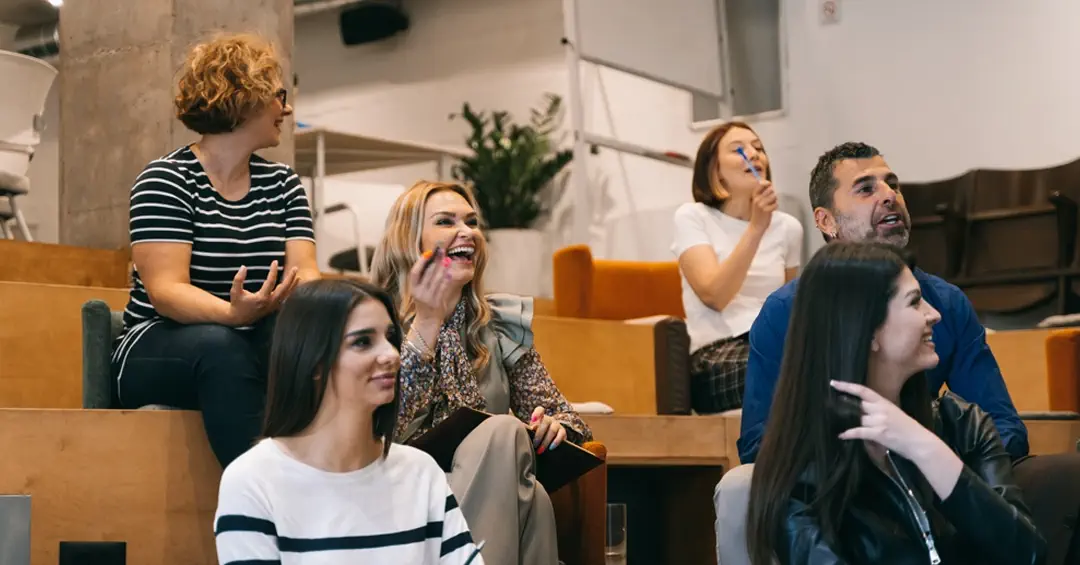In recent years, small-format events — or microevents — have been gaining ground as a strategic alternative to large congresses or trade fairs. Demand for small-scale events has grown by 23% in the past year. This format enables deeper personalisation, stronger brand connection, and closer relationships with attendees — precisely because the size favours intimacy and interaction.
For event managers, designing experiences for small groups — in other words, crafting truly intimate experiences — offers a competitive advantage: lighter logistics, greater control, higher engagement, and clearer ROI.
Why Focus on Intimate Experiences for Small Groups
- Higher interaction between attendees and brand, facilitating meaningful conversations.
- Flexibility to personalise content, pacing, atmosphere, and services.
- Better measurement of individual impact and experience quality.
- Alignment with premium audiences such as VIPs, key clients, or brand ambassadors.
- Easier innovation through smaller, boutique-style logistics.
Designing for small groups means thinking from a first-person perspective: What does each participant feel? What connections are being made? How can we turn an event into a lasting memory?
Key Elements for Designing Microevents
Audience, Objective and Format
Begin by defining the attendee profile. Microevents typically host between 10 and 50 participants, sometimes even fewer depending on context.
Next, clarify the objective: product launch, executive training, VIP meeting, client loyalty event, or intensive workshop. Each requires a tailored strategy.
Then, choose the format: roundtable, retreat, experiential workshop, private dinner, or boutique pop-up. The goal is always to foster connection and active participation.
Ensuring coherence between audience, objective, and format guarantees that the microevent feels bespoke — not merely a “mini conference”.
Content and Storytelling
In small-group settings, storytelling is essential: a strong narrative ties everything together and reinforces the brand connection.
- Personalised content: Fewer participants allow for customised messaging and activities that align with guests’ interests, challenges, or industries.
- Active participation: Encourage open dialogue, co-creation, and knowledge exchange in intimate settings.
To make the experience truly memorable, align your content with the group’s needs and design a space that promotes fluid, meaningful conversation.

Space, Atmosphere and Services
The physical or hybrid setting defines the tone of exclusivity and connection — from décor and lighting to layout, rhythm, and catering.
Hosting an event in a villa, showroom, or boutique venue rather than a standard hotel can instantly elevate the experience.
- Personalised service: Individual attention, high-quality materials, tailored welcome kits, and designed “surprise moments.”
- Smooth logistics: Efficient check-in, technology-enhanced support, and a schedule aligned with the group’s pace.
Technology and Personalisation
Even for small-scale gatherings, technology can greatly enhance the experience:
- Personalised digital registration and check-in systems.
- Event apps for viewing agendas, connecting profiles, and booking one-to-one meetings.
- Real-time data tracking to fine-tune engagement and dynamics.
Personalisation should span the entire attendee journey — not just the content delivery.
Measuring Impact and Follow-Up
Microevents allow for more nuanced, qualitative evaluation thanks to their smaller group size.
Set clear KPIs such as participation levels, satisfaction, meaningful connections made, engagement time, feedback quality, and qualified leads.
Post-event tools can help collect and interpret data. The reduced scale makes it easier to extract meaningful insights: Who connected with whom? What feedback surfaced during one-to-one exchanges? What follow-up actions were taken?
This level of insight transforms microevents into strategic investments with measurable returns.

Real Examples of Microevents from Global Brands
Apple – Exclusive Launches for Key Audiences
Apple complements its iconic large-scale keynotes with boutique-style launches for the press, influencers, and strategic clients — featuring hands-on demos, controlled environments, and valuable networking opportunities.
Chanel – Couture Collections for VIP Clients
Chanel unveils its haute couture collections in intimate events held in Paris, New York, and Tokyo, inviting VIP clients and selected media. The smaller scale amplifies exclusivity and emotional engagement.
Pharma and Consulting Sectors – Executive Training and Strategic Meetings
Industries such as pharmaceuticals and consulting employ microevents for specialist seminars or client workshops, where smaller groups support deep learning and open dialogue.
These examples show that microevents aren’t limited to luxury brands — any MICE organisation can adapt this format to its own strategy.
MICE Trends Influencing Microevents
- Sustainability: Smaller events simplify sustainable practices — less waste, reduced travel, local suppliers.
- Brand personalisation: Attendees expect experiences that reflect their values and sector identity.
- ROI measurement: With better focus per attendee, microevents meet growing demand for investment accountability.
- Wellbeing and human-centric design: Calmer formats and mindful pacing foster comfort and cognitive balance.
Microevents align perfectly with the MICE sector’s evolution towards more meaningful, measurable, and human-centred experiences.

Step-by-Step Checklist for Planning a Microevent
- Define audience and goals.
- Select format and scale.
- Design the narrative and content.
- Choose the right venue and ambiance.
- Integrate technology and personalisation.
- Craft the attendee journey: from welcome to interaction and emotional connection.
- Manage logistics carefully.
- Measure and follow up: collect data, analyse impact, and share results.
- Plan pre- and post-event communication: exclusivity messaging, attendee prep, and personalised follow-up.
- Reflect and improve for the next edition.
Best Practices and Common Pitfalls
Best Practices
- Limit attendance to ensure intimacy and quality.
- Combine structured and informal interaction times.
- Personalise invitations and content.
- Use technology meaningfully, without losing the human touch.
- Create emotional or surprise moments.
- Measure success beyond attendance numbers.
- Ensure seamless logistics — mistakes are more visible in small events.
Make the format part of the brand experience.

Common Mistakes
- Treating the event as a “small version” of a big conference.
- Underestimating the need for personalisation.
- Neglecting a clear purpose or narrative.
- Skipping follow-up and data collection.
- Overusing technology that distracts rather than connects.
- Choosing an unsuitable venue that undermines the desired atmosphere.
Conclusion
Designing microevents for small groups is a powerful strategy for building authentic connections, driving engagement, and achieving measurable ROI in today’s MICE ecosystem.
By embracing intimacy, personalisation, and smart technology, event managers can differentiate themselves and deliver experiences that genuinely resonate.
With these insights and best practices, you’re ready to design microevents that captivate audiences and stand out in the modern events landscape.
About Eventscase
The Eventscase platform helps event organisers manage corporate events, conferences, and trade shows, whether large, small, in-person, hybrid, or virtual. No technical skill is required at all. Anyone can create beautiful event websites, registrations, badges, perform check-ins, event apps, 1:1 meetings and more. Everything under the brand and domain of your company can be implemented with an Eventscase whitelabelled platform.
If you would like to subscribe to our newsletter to get live updates on everything related to our platform – news, blogs, events, announcements and much more, please, register here.

